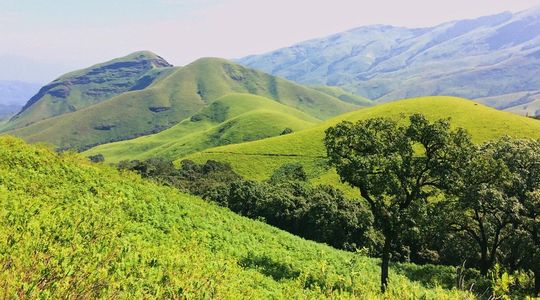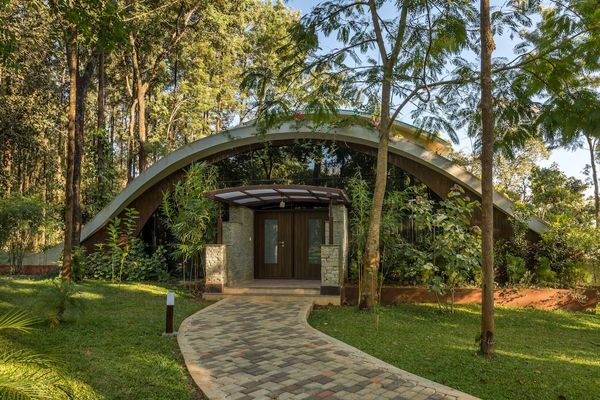Secrets of Kudremukh National Park: Flora, Fauna, and Trails
 Palakshi Meharwal
17 Jul, 2025
7 mins read
52
Palakshi Meharwal
17 Jul, 2025
7 mins read
52

Nestled in the heart of Karnataka’s Western Ghats, Kudremukh National Park is a verdant paradise that enchants nature lovers, trekkers, and wildlife enthusiasts alike. Spanning over 600 square kilometers, this protected area boasts an extraordinary blend of biodiversity and scenic trails that reveal the ecological richness and cultural heritage of the region. Beyond its breathtaking landscapes, Kudremukh holds many secrets—from its unique flora and fauna to the adventurous trekking routes waiting to be explored.
A Rich Tapestry of Flora
One of Kudremukh’s most striking features is its dense forest cover, dominated by tropical evergreen and semi-evergreen species. The park lies within one of the world’s eight "hottest hotspots" of biodiversity, the Western Ghats, which makes it a sanctuary for a diverse array of plants. Towering trees such as teak, rosewood, and Indian laurel create a canopy that shelters the undergrowth.
The park is also home to rare medicinal plants and endemic species, contributing to its ecological importance. For instance, the rare Neelakurinji flower, which blooms once every 12 years, paints the hills with a stunning shade of blue, drawing visitors from across the globe. The varied altitude—ranging from around 600 to over 1,900 meters—supports different microhabitats, enabling a rich mix of ferns, orchids, and wildflowers to flourish.
Wildlife: An Untamed Wonderland
Kudremukh is a haven for wildlife, sheltering a host of mammals, birds, reptiles, and insects. Among the park’s most famous residents is the lion-tailed macaque, a primate species endemic to the Western Ghats and listed as endangered. The presence of this elusive monkey highlights the park’s role in conserving fragile wildlife.
Large mammals like the Indian bison, locally known as gaur, roam freely through the forest. Other inhabitants include spotted deer, sambar, wild boar, and the occasional elusive tiger or leopard. Birdwatchers will find Kudremukh particularly rewarding, with over 200 species recorded. From the vibrant Malabar trogon to the regal Great Hornbill, the avian diversity adds a splash of color and sound to the serene environment.
Trails That Tell a Story
Beyond its natural treasures, Kudremukh National Park is famed for its trekking trails that invite adventurers to explore its hidden corners. The most popular trek leads to the Kudremukh peak, one of the highest points in the park at approximately 1,894 meters above sea level. The ascent offers panoramic views of rolling hills, dense forests, and sparkling streams.
This trek is a moderate to challenging endeavor, typically spanning two days, and takes hikers through shola forests, grasslands, and alongside picturesque waterfalls. Along the way, trekkers can spot endemic flora and fauna, making the journey both physically rewarding and educational. The trails are well-marked but require good preparation and guidance due to sudden weather changes and the park’s rugged terrain.
Another noteworthy path is the Sonpet to Kudremukh trek, which is less frequented and ideal for those seeking solitude amidst nature. It passes through remote villages and untouched wilderness, providing insight into the local culture and lifestyle of the indigenous communities.
Conservation Efforts and Visitor Guidelines
Kudremukh National Park is managed by the Karnataka Forest Department, which has implemented several measures to protect its delicate ecosystems. Strict regulations on littering, camping, and trekking are enforced to preserve the park’s pristine condition. Visitors are encouraged to follow eco-friendly practices, such as carrying reusable water bottles, avoiding plastic, and respecting wildlife habitats.
In addition to preserving biodiversity, the park plays a critical role in watershed management for the region. Its dense forests help regulate river flows, prevent soil erosion, and maintain groundwater levels, which are vital for the surrounding agricultural communities.
When to Visit and How to Get There
The best time to visit Kudremukh Park is between October and May when the weather is pleasant and trails are accessible. Monsoons, from June to September, bring heavy rainfall, which transforms the park into a lush green wonderland but can make trekking hazardous.
Kudremukh is accessible by road from major cities such as Bangalore and Mangalore. The nearest railway station is in Udupi, about 60 kilometers away. Visitors are advised to plan their trips with local guides who are familiar with the terrain and safety protocols.
Final Thoughts
Kudremukh National Park remains a hidden jewel in India’s vast natural heritage. Its combination of rich flora, diverse fauna, and exhilarating trekking routes offers a holistic experience for all who venture here. Whether you are a botanist, wildlife photographer, or adventure seeker, Kudremukh unveils its secrets gradually, rewarding patience and respect for nature.
Exploring this park is not just about witnessing scenic beauty but also about understanding the delicate balance of ecosystems and the importance of conserving such pristine environments for future generations.
Written By:
Palakshi Meharwal



Hotels at your convenience
Now choose your stay according to your preference. From finding a place for your dream destination or a mere weekend getaway to business accommodations or brief stay, we have got you covered. Explore hotels as per your mood.


